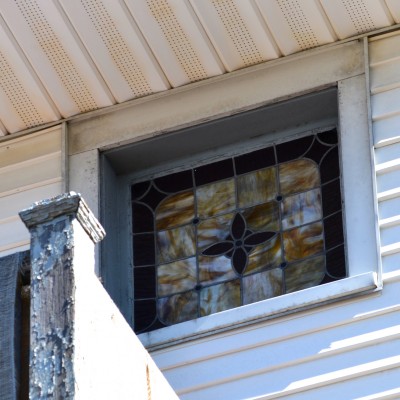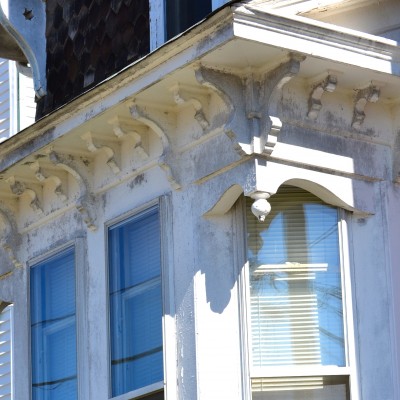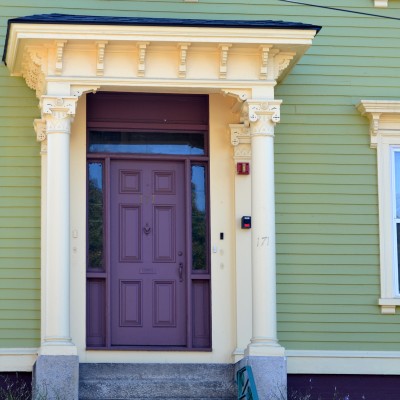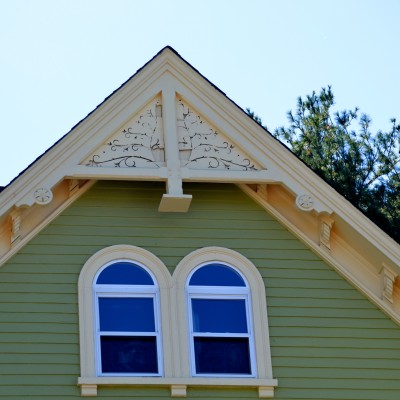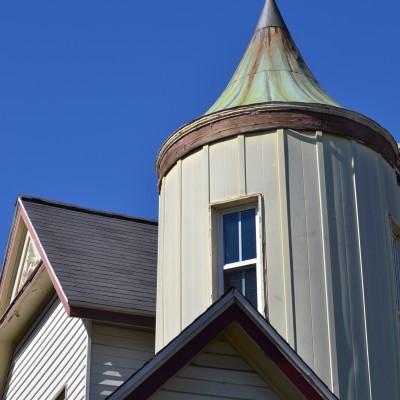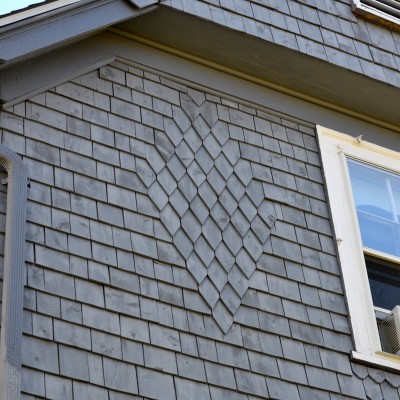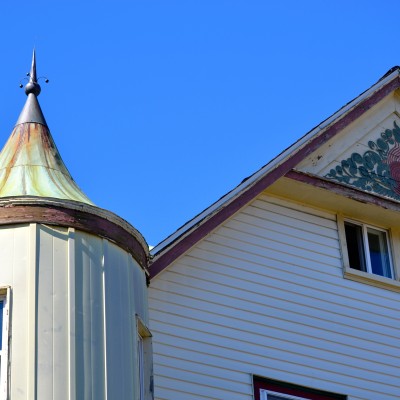EPHS Watchemoket Square Self-Guided Walking Tours
EPHS Walking Tours (printable)
Watchemoket Walking Tour #1: “Queen Anne Land” Walnut/Cross/Summit Streets
The tour begins on Taunton Avenue at Gilmore’s Flower Shop, goes down Walnut to Cross, takes a left and another left onto Summit, ending back at 62 Taunton. We estimate our tours to take about 45 minutes.
East Providence was incorporated as a town in 1862 (it became a city in 1958), and the heart of EP was the Watchemoket Square business district, the waterfront, and the housing stock which began to climb the Warren/Taunton Avenue hills. The area of this tour was built up between 1880-1920 and coincided with the 1890 rise of a professional class in the general area which wanted to own. By 1895, the Watchemoket area population had risen from 800 to 6,000. The land rising up from the Seekonk had a grand vista and was convenient to downtown Providence and the EP center. Most of the first houses there were large, built in the Queen Anne/shingle style with towers, porches, florid architectural detail, large lots, and carriage houses. Much of this is still visible if you peek down driveways and up in the air. (Some houses only got a “redo” on the first level) When the first flurry of building was done, an “infill” of smaller houses followed with cookie cutter similarity- it is easy to spot a row of late 1890 – 1910 houses. By the 1920s, the area was built up – with room only for a few Craftman styles bungalows.
QUEEN ANNE STYLE : 1880-1910 LOOK FOR: wraparound porches, overhanging eaves with heavy bracketing, towers, interesting high roof lines with dormers, carvings, porches, patterned wood shingles of all designs, bay windows, specialty windows, leaded /stained glass, ornate chimney work, slate roofs, more than one color, double front doors, gingerbread trim, 3rd floor overhangs, recessed doorways.
SHINGLE STYLE : 1880-1910 – LOOK FOR some of the details mentioned above but with shingles used as the main exterior covering. (Think of those grand cottages on the RI shore) Houses had a weathered look with stone foundation and tended to be low in mass but there are many interpretations of this style as with the QUEEN ANNE.
YOU ARE HERE: 76 Taunton Avenue – Gilmore’s Flower Shop. This building was hauled on wooden rollers by teams of oxen from the Valley Street area. It was Williams Funeral Home until 1936 when the Gilmores opened shop. Across the street stands the 2nd Baptist Church, whose bell tower greeted the traffic coming up from the Square.
Much of what you see at the beginning of this tour is housing stock that has been radically changed. You can see vestiges of bracketing, a good bonnet, and original doors but #s 34, 47 and 60 WALNUT are the first houses which gives you a true sense of what has been covered over or lost.
68 WALNUT : a puzzle house which perhaps might be called Italianate but it is hardly ornate enough. One survey speculated that it may have been moved to this site as the Queen Anne to its left may have owned that lot also.
76 WALNUT: We especially like the porch and the carriage house – peek down the driveway. This is an elegant house which still commands attention.
88 WALNUT: the queen of the Queen Anne’s in the area and for sale! Don’t miss the carvings, that grand little turret with its copper cone, and the sweet little windows tucked up high. This house needs some attention to detail but it is a wonderful example.
98 WALNUT: commanding the corner (now that #106 has burned) is a great Queen Anne cottage with gingerbread, bumpouts and details galore. Take your time at this place. And speaking of #106, look at 120 Walnut if you want to know what was lost.
You are now at CROSS STREET: turn left and come to the engaging backyard gate of 129 SUMMIT. This shingle style cottage anchors the corner of Summit/Cross beautifully and may have had the lot next door at 125 as well. Turn left onto Summit here.
125 SUMMIT: This 4 square house is a popular 1910 design and it is scaled down for its site very nicely. Note the neo-colonial columns and the 3rd floor dormer, a usual feature.
This is good spot to start looking for spec houses built 1890-1910. Check out an original at # 105! Now look at the houses in the #80s to see if you can find the most amazing aluminum siding job in town. Are the original brackets still there at # 81? (1894)
88 SUMMIT: A look out the backyard says it all about the site of this house -a shingle style with almost a RI shore look to this place with its wraparound porch.
59-49 SUMMIT: Sometimes we get lucky and there are two houses close together which teach just by being there. Both1920 Craftsman designs, #49 even has the original garage.
32-34 SUMMIT: This is the sleeper on the tour. If you get too close, you miss the good parts. Back up on the same side of the street and look up – we almost missed this one!
20 SUMMIT: We date this about 1895 since the roof line is so reminiscent of the Pump House at Hunts Mills. But it has the 1900 4 square and dormer too, so perhaps this is someone’s wish list of all the things they liked about house styles of that time?
10-12 SUMMIT: We liked the way this plain, honest shingle house sits on its site. What a view it must have had over the Square and the waterfront.
62 TAUNTON: We would have chosen that top tower room as our bedroom wouldn’t you? This house has it all and has been lovingly maintained. By now you are a pro at recognizing a Queen Anne. Enjoy!!
NOTE: There a very definitive dates for most of these houses. If you know more about any of these buildings please go to www.ephist.org to contact us. We would love to add to our knowledge.
Watchemoket Walking Tour #2: 4th, 5th, 6th Streets It’s All in the Details: Porches, Doors, and Towers
QUEEN ANNE style -1880-1910 LOOK FOR: wraparound porches, overhanging eaves, towers, interesting roof lines, intricate dormers, second story balconies, PORCHES with lots of details and different shapes, recessed doorways, patterned wood shingles of all design including those resembling fish scales, bay windows, oriels (special windows), leaded /stained glass windows, monumental chimneys, slate roofs
SHINGLE Style -1880 – 1910 – this style is associated with the Queen Anne and is identified by its use of shingles as a main exterior. There can be towers, lots of interesting additions to a building, stone foundations, The exteriors often had a weathered look, with the shingles treated to look that way from the beginning. (Think Victorian cottages on the RI shore) Shingle houses tended to be low in mass but of course there’s a tremendous variety in this style as well as Queen Anne.
***YOU ARE HERE**** St. Mary’s Episcopal Church- 1870 ( the little brown church)
was designed by architect G.E. Harney in the Gothic Style and was originally a board and batten exterior. The exterior was changed to its present shingle look in 1889 but notice the pointed windows, ½ rosettes, eyebrow windows, and the trim of the front entry porch. St Mary’s was placed on the National register in 1980.
#10-12 4th Street: You should be walking alongside the church on 4th Street now and just as you pass the church, look across the street at the high blue gray double house which was built in 1895 in the shingle style. Think of it as a duplex with mirror image living quarters. The entryways are spaced far apart for privacy.
Take a quick look at the very nice porch still in its original condition at #14 but then spend most of your time looking at one of the best remaining examples of Queen Anne style left in the City. # 18, the Pierce House, was built in 1892 by a contractor named Pierce who also served as Police Chief. A slate roof, stone foundation. brick siding and decorative concrete work make this house a stand-out. It is on the National Register.
When you get to Mauran Avenue at the end of the block, glance to your right across the street at 149 Mauran, the nifty 1920’s light green Craftsman style bungalow with stone porch supports and original varnished door. Most of these bungalows get their porches enclosed or undergo some other transformation but this one is a gem.
Heading uphill, at 158 Mauran you can see original doorways and a roomy porch with great bracketing supports in vivid colors.
173 Mauran and 37 5th Street: These two Queen Anne tower houses at opposite corners of Mauran and 5th are a great way to contrast two houses perhaps built by the same builder. You can see the same shape and style but also how each house has been altered over the years. Again, the porches tell the story.
37 5th Street retains its upper porch bracketing and rounded top window. It also comes with some intriguing outbuildings, including a large barn and 4 bay garage.
On down the street, on the right, you notice a trio of Dutch colonials with their distinctive barn like roofs. When you get to the end of the street you wonder if these houses were meant to add some continuity to infill housing since the big 1890 Dutch colonial at #9 is so imposing. (Oh, don’t forget to note the unique porch at #13 –about 1895)
You are now at Warren Avenue again and should head up the hill for a look at 6th Street. At 101-103 Warren, make sure you note the three-storied porch façade built about 1915, with original columns and support work. What a great place to watch any parades!
As you turn the corner into 6th Street, you will walk by a wrought iron low fence in front of a very unimposing little dark green house with red trim at #7. By now you should be a little familiar with the Queen Anne style. Take particular note of the recessed doorway and the deeply overhanging second story. A glance back at the side of the house as you pass reveals a stained glass window. Check out the stained glass across the street.
Across the street at # 6 is a house we almost missed as it has been rendered almost unrecognizable from the period in which it was built. But on closer look, we realized that the doors are original as are the stained glass windows up the front façade. One wonders what the front facade on this house must have looked like.
At # 9, (1882) there is a caramel colored peak front house with great detailing, which is undergoing some tender loving care. Make sure you look at the sides of this house. and the unique little window roofs.
At #12 (1884) you have a real treat similar to standing before 18 4th Street – a Queen Anne with all the original detail visible. Make sure you look at the sides of this house as they were meant to be very visible also. Don’t you think the pink fretwork is neat? This is a winner of the style and we hope it will retain all its qualities.
At #28, the treasure is not in the front yard., although that chimney sure is interesting. Look behind the main house to the carriage barn (1884) with the original door on the second story –we suspect the lower bays had the same doors.
At the corner of Mauran and 6th, #191 Mauran, there is a 1920’s bungalow with original details, which you can contrast, with the bungalow at 17 6th Street, which you just passed but most likely didn’t give thought to. As you did with the tower houses, can you see the overall style of the two houses and the changes made to the 6th Street house?
You have come to the end of our self-guided tour but we bet that you now could easily walk the rest of the neighborhood identifying remaining architectural elements that we have missed perhaps. We hope you have enjoyed this walk around Watchemoket!
EPHS contacts : www.ephist.org or call 438-1750
Watchemoket Walking Tour #3: Potter/School/Purchase/Freeborn/Potter Streets
This tour has posed many more questions than we have found definitive answers for. Where did the houses go that were condemned by the building of 195 in 1957-58? Were some moved? If so, which ones to where? Did the houses standing at 49 and 85 School Street just go across the road? Our 1956 map shows vacant lots at those sites but obviously these houses were built as much as 75 years before. So as you take yourself around this year’s route, please realize that some conjecture is taking place in our minds and that we welcome any hard and fast dates you can furnish or lead us to.
11 Potter Street: This house is truly one of our puzzles. Our 1895 map shows a building on the site with a large open lot up to the corner of School Street. At second and third glance, this house just begs to be labeled Greek Revival which would put it into the 1830 – 1860 range. You will notice that today the open space to the corner is taken up by a late Italianate and both of them are covered with a brown shingle-like material. When one looks up the plat map, #11 no longer exists but there is a note at 49 School Street which indicates “multi-dwellings.” We’re rooting for some confirmation that 11 Potter may be one of the oldest houses in the area.
49 School Street: At first glance, this house wasn’t going to make the tour. At third glance we noted that it wasn’t there in 1956 but was definitely an Italianate ( 1880-1890) which led us to surmise that it had been moved. It still has some of its bonnet left and the top of the sideboards near the roof so it may have been grand or well loved enough for someone to think it merited the move. And perhaps under that brown shingle is the original siding/trim on one or both houses?
51-53 School Street: There are not many tenement houses of this scale here in town so we surmise this may have been a mill residence of sorts. The roofline would speak late Gothic Revival and echoes the roofline of the house at 56 Freeborn across the highway, and the house at 48 Potter. The building was there in 1895 so we feel inclined to put a date of 1860 – 1870s with a gentler roofline than the early severe Gothic gables.
**** Note the massive granite stone steps/ edging to the left of the above building. Were homeowners allowed to take steps and foundation stones from the demolished buildings across the way to use on their own property?
61-63 School: This is the other of our puzzler houses. We have given this brick house many glances and always come away feeling that this is a special house. The eyebrow window in the basement is fantastic –usually they are in attics. Note the changed window lines with the faint telltales of arched windows and the archway above the front door which is on the upper side of the street. This Dutch Colonial is on our 1895 map so we are pretty sure it’s older than the 1930 date the City has for it. Anyone?
On last year’s tour we came across a similar formation of buildings on upper 5th Street. We now realize that both buildings were carriage/ horse rental stalls and there was another, demolished, on Freeborn. Are these the only two left in the City?
85 School Street: We were delighted to see the good care this grand Italianate has been getting. The doorway is a splendid example of Italianate design and the house has good proportions and had fine trim, hopefully still there under the siding. Again, this house sits on a lot which was empty in 1956 but obviously this was a house worth saving and moving. We tentatively date this house 1880-1890.
56 Freeborn: The next three houses on the tour caught our eye because of similar design. Our 1895 map shows all but one of the houses on that side of what was then called Sutton to be standing at that point. But we decided to focus on 56, 52, and 44-46 because of the underlying cottage style of Greek/Gothic revival which was used in the 1830-1880s. With the arrival of balloon framing in 1830, houses could be built quickly and with a crew of 2-3 men. The fronts of cape style houses could now be higher to accommodate more headroom upstairs and small windows even fitted into that space. The Gothic idea of having a steep gable rise up from the roofline instead of having a dormer has been gentled in 56 Freeborn and 48 Potter and is echoed across the highway at 51-53 School. #56 has been remodeled extensively but just look next door.
52 Freeborn: this house is a plain, honest cottage Gothic style that still retains its original lines. We are dating it 1860-1870s.
44-46 Freeborn: when we checked the records this house came up as 1940!!!Can you see the similarities to #52 and #56 if you go to the west end of the house? The heavy Italianate bracketing, bays and bonnet point to a remake of this house sometime around 1880-1890. It’s a charmer and may be the oldest of the three.
33 Potter: This house gets our praise for the sensitive way the siding work was done. Again, this house shows on the 1895 map and is earlier than the 1910 attributed to it in City records. Note the narrow double windows and the decorative panes in the front windows. The bonnet, the deep overhangs and returns and intact bracketing make this a winner on this year’s tour. 1880- 1890 Italianate cottage? Very charming!
47 Potter: We mention this Greek revival because we can actually date the house to 1867. You can easily see the raised front and the proportions which match the houses on Freeborn. What else can you spot about these houses?
48 Potter: Gothic or Greek? This is a great example of another house which was there before 1895 although its bonnet would say 1920 Colonial Revival. All the things you have noticed about the Freeborn houses come into play here as well.
55 Potter: We liked this house for its great bonnet and for the owners trying to imitate a bit of what was covered up. It’s an 1880-1890 Italianate, a rare five bay type for the area.
10 Orchard. Looking over to #10, you should immediately be able to state “That’s a Greek Revival -1860! “ This is a house in its original state – pretty amazing in this day.
Retracing your steps over Potter Street to St Mary’s, you approach the highway. To your right, down over the hill was the Andrade family house at the corner of Freeborn/Taunton which was moved to 170 Summit Street. The rest of the land to your right up to School Street was just that – the Potter Street School and yard which took up two lots. Built in 1840s, it did not survive 195.
We hope you have had fun walking this tour. We welcome any information you may have about any of these buildings or about the construction of 195. And please let us know if you have any information which would change how we are thinking about these buildings thus far. www.ephist.org or 438-1750
Here are some of the homes on the tours – Photos by Becky Ellis
